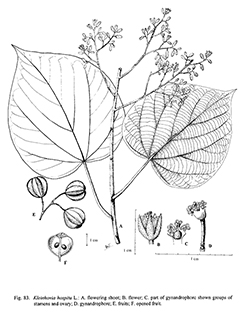e-Flora of Thailand
Volume 7 > Part 3 > Year 2001 > Page 586 > Sterculiaceae > Kleinhovia
Kleinhovia hospita L.wfo-0000357456
Sp. Pl.: 1365. 1763; Mast. in Fl. Brit. Ind. 1: 364. 1874; Gagnep. in Fl. Gén. I.-C. 1: 497. 1911, Ridl., Fl. Malay Penins. 1: 280. 1922; Craib in Fl. Siam. Enum. 1: 171. 1925; Kou-mei, Fl. Reipubl. Popularis Sin. 49(2): 144, fig. 40. 1984. Fig. 83.
Accepted Name : This is currently accepted.
Description : Small tree, up to 10 m high, with straight trunk; bark greyish brown, smooth; young twigs hairy then glabrescent. Leaves heart-shaped or ovate, 5–15 x 6–12 cm, apex acute, cuspidate or rounded, base cordate to truncate, chartaceous, glabrescent; 5–(7) nerved at base, scalariform veins distinct on lower surface. Petiole 3–8 cm long. Inflorescence a panicle of compound cymes, up to 30 cm long. Buds oblong ca 5 x 3 mm, twisted and curved to one side. Flowers pink. Sepals free, unequal oblong or narrow triangular, ca 5 x 1.5 mm, hairy externally. Petals free, unequal, oblanceolate, 3–5 x 1.5–3 mm, glabrous except near curved or hooked base. Stamens 10; staminodes 5, shorter than stamens. Ovary ovoid, hairy, 5-locular; style simple; stigma narrow, pointed. Fruit inflated pyriform, 2–3 x 1.5 cm, membranous, with 5 longitudinal lobes, dehiscent from top to the base. Seeds globose.
Thailand : CENTRAL: Saraburi, Krung Thep Maha Nakhon (Bangkok); PENINSULAR: Nakhon Si Thammarat.
Distribution : India (type), Ceylon, S China, Taiwan, Malay Peninsula, Indonesia, the Philippines, Australia, Polynesia, W Africa.
Ecology : Cultivated as an ornamental and often spontaneous in open spaces near streams. Flowering and fruiting: February–April.
Vernacular : Cham cha (ฉำฉา), chom phu phuang (ชมพูพวง), po farang (ปอฝรั่ง)(Central).
Uses: As ornamental tree.

